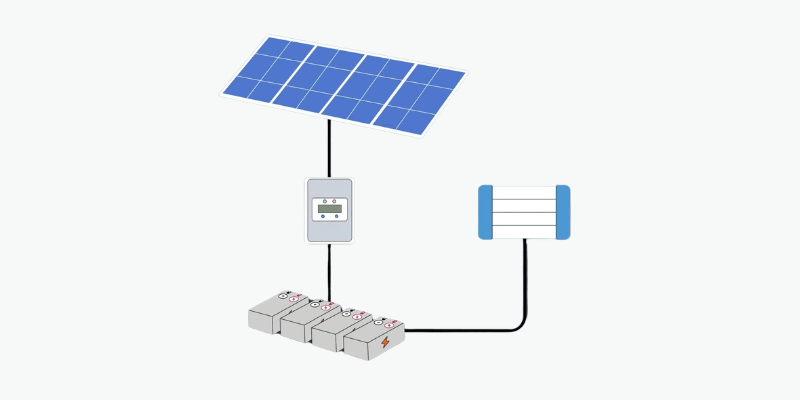Markedet for Solar Systems off-grid forventes at nå 5,8 milliarder dollars i 2031, drevet af ønsket om at eliminere strømregninger og undgå blackouts. At forstå de vigtigste komponenter i disse systemer er vigtig for dem, der ønsker at deltage i millioner ved hjælp af solenergi. Lad os udforske!
Hvad er et off-grid solsystem?
En Off-grid solsystem Bruger sollys til at imødekomme alle dine strømbehov uden at oprette forbindelse til nettet. Disse systemer er populære til at minimere miljøpåvirkningen og reducere månedlige udgifter. De er ideelle til rvers, campister og sejlere, der søger pålidelig strøm væk fra etablerede campingpladser eller landkraft, hvilket fremmer en mere uafhængig livsstil.

Bygning af et off-grid solsystem
Et off-grid solsystem involverer mere end bare solcellepaneler. Det kræver Solpaneler For at fange sollys, en solopladningscontroller til konvertering af energi, en batteribank til opbevaring og en inverter til brug. Uden ordentlig konditionering kan denne elektricitet skade batterier.
Generelt regulerer en solopladningscontroller spændingen og strømmen fra panelerne for sikker opbevaring i en 12-volt DC-batteribank. For de fleste applikationer har du også brug for 120-volt AC-strøm, som en inverter leverer ved at konvertere DC til AC til dine forretninger.
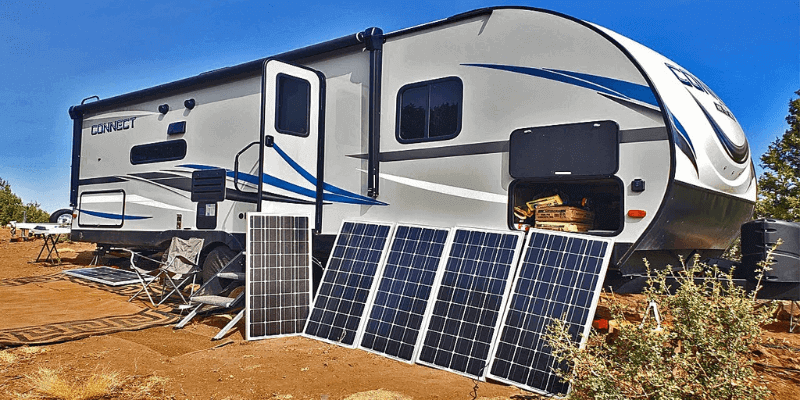
Solpaneler
Når du opretter et off-grid solsystem, skal du overveje de forskellige typer solcellepaneler.
Tyndfilm- og halvfleksible paneler er lette og ideelle til både eller RV'er, fordi de kan bøje sig for at passe buede overflader, selvom de ikke er de mest effektive.
Multikrystallinske og monokrystallinske paneler ser ens ud, men adskiller sig i effektivitet. Monokrystallinske paneler tilbyder normalt højere effektivitet, men er dyrere. De er perfekte til hjem eller flade områder som tag eller marker, der klarer sig godt i varmt vejr og svagt lys. For top-notch off-grid-præstation er monokrystallinsk generelt din bedste indsats!
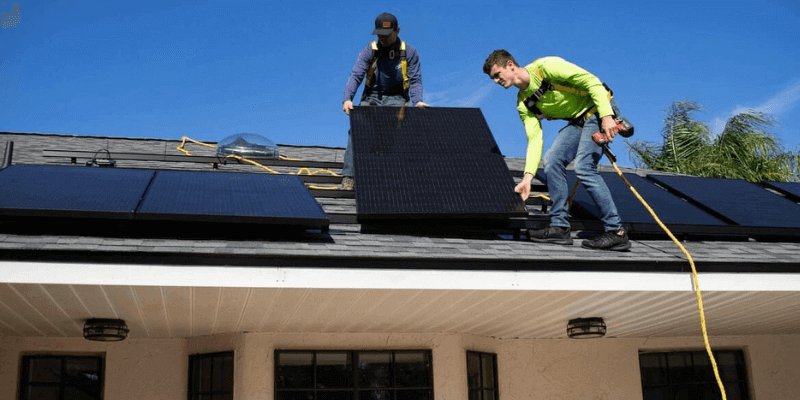
Solar Charge Controller
En solopladningskontrol forhindrer batteri overopladning og optimerer energioverførsel. Der er to hovedtyper:
1. PWM -controllere: overkommelige, men mindre effektive, egnede til små systemer med matchende panel- og batterispændinger.
2. MPPT-controllere: Boost effektivitet med 15-30%, ideel til større systemer under forskellige sollysforhold. Avancerede modeller tilbyder temperaturkompensation og fjernovervågning.

Off-grid Power Inverter
De fleste apparater kræver AC -strøm, så vi har brug for en strøminverter til at konvertere DC -energi til AC -strøm.
Ren sinusbølgeinvertere passer til følsom elektronik, mens modificerede sinusbølgeinvertere er fine til basale apparater.
For at vælge den rigtige inverterstørrelse skal du summe watt på dine enheder. For eksempel anbefaler en 1, 700-watt mikrobølgeovn, 200 watt lys og et 600-watt køleskab en 3, 000-watt (3 kW) inverter.
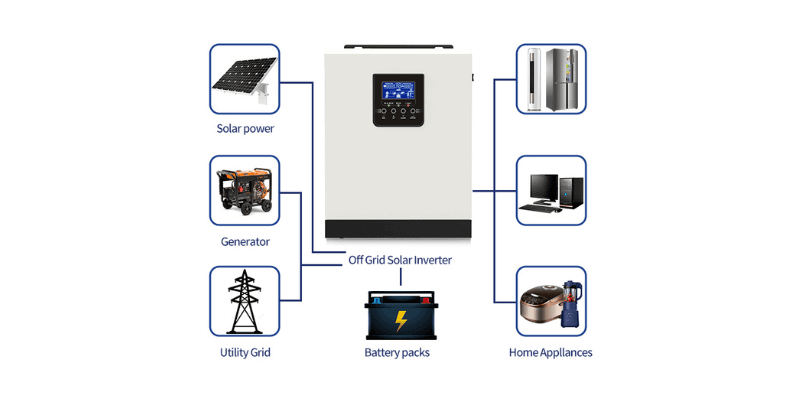
Den vigtigste del af en off-grid solopsætning: batteriet
Batterier påvirker pålideligheden og levetiden. Her er to hovedteknologier:
Bly-syre batterier
Deep-cycle bly-syre Batterier har længe været det foretrukne valg for biler, RVS, både og solopsætninger. De er lette at finde og effektive. Imidlertid opbevarer de typisk ikke meget energi, mangler effektivitet, har en begrænset levetid og kræver betydelig vedligeholdelse.
Fordele
- Lavere omkostninger på forhånd (50% -70% billigere end lithiumbatterier)
- Bevist pålidelighed i off-grid-applikationer
Ulemper
- Tunge (lithium er kun halvt så tunge)
- Kortere levetid (500-1.000 cyklusser)
- Højere vedligeholdelse (f.eks. Elektrolytpåfyldning)
- Begrænset Udladningsdybde (50% mod 80% for lithiumbatterier).

Lithium batterier
En voksende tendens i off-grid solsystemer bruger dybcyklus lithiumbatterier til energilagring. Disse batterier bruger lithiumsalt og leverer effektive og lette opbevaringsløsninger.
Fordele
- Lys (ca. 50% af blybatterier)
- Længere levetid (1.000-6.000 cykler)
- Højere energitæthed (op til 260 Wh/kg)
- Minimal vedligeholdelse og hurtigere opladning
Ulemper
- Højere indledende omkostninger (2-3 gange bly-syre)
- Følsom over for ekstreme temperaturer uden termisk styring
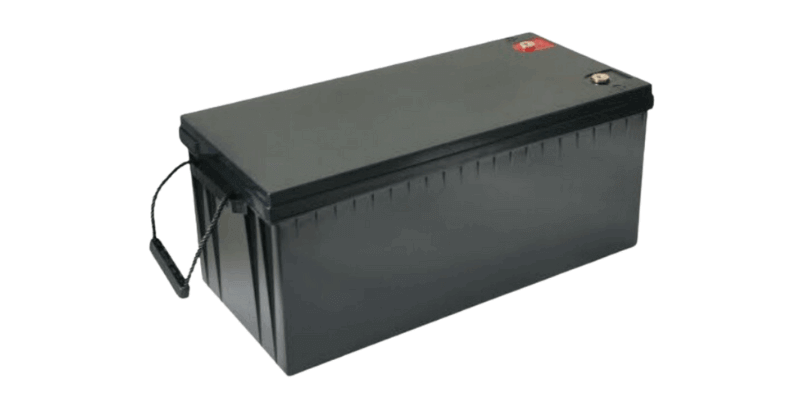
Hvor meget koster et off-grid solsystem?
Solsystempriser for solsystemer varierer baseret på dine behov.
- For at drive en RV eller camping koster en lille opsætning med et 100W -panel og et 100 AH -batteri et par hundrede dollars og er let at installere til basale gadgets.
- Til en hytte har du brug for omkring 1.000 watt paneler, en 3.000-watt inverter og omkring 400 AH i batterier, der koster mellem $ 5.000 og $ 10.000 afhængigt af batterierne.
- Det er dyrere at gå fuldt ud af gridet derhjemme; Forvent at bruge over $ 25.000 til mindst 12.000 watt paneler og flere invertere med op til 1.200 AH -banker. Det er komplekst, så professionel installation tilrådes.
Andet udstyr til solcellesystemer til grid
Så vi har dækket det grundlæggende i et off-grid-system, men du har brug for et par flere ting for at afslutte det. Du vil bestemt have en batteri -skærm, ledninger, sikringer og distributionsstænger. Sørg for, at alt er vurderet til dit systems størrelse og skal undgå brandfarer. Hvis du er usikker på noget, er det altid klogt at konsultere professionelle!

